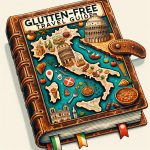Traveling to Italy with dietary restrictions can be challenging, especially for individuals with celiac disease or gluten intolerance. In this blog post, we will explore the concept of gluten free travel cards and their significance for travelers in Italy.
From understanding the challenges of dining gluten-free in a foreign country to finding resources and support, we will cover everything you need to know about using a gluten free travel card in Italy. Whether you’re planning a trip to Rome, Florence, or Venice, having a gluten free travel card on hand can make all the difference in enjoying your Italian culinary experience without compromising your health.
Understanding Celiac Disease and Gluten Intolerance
Gluten intolerance and celiac disease are serious medical conditions that can significantly impact a person’s ability to travel and enjoy new culinary experiences. Celiac disease is an autoimmune disorder that causes the body to react negatively to gluten, a protein found in wheat, barley, and rye. On the other hand, gluten intolerance refers to a sensitivity to gluten that may not be as severe as celiac disease but still requires individuals to avoid consuming gluten-containing products.
Traveling with these conditions can present challenges, especially in countries where the language barrier and cultural differences may make it difficult to communicate dietary restrictions effectively. This is where understanding the nuances of celiac disease and gluten intolerance becomes crucial for travelers. Being informed about the specific ingredients to avoid, as well as being able to recognize safe alternatives, can greatly enhance the travel experience for individuals with these conditions.
It is important for travelers with celiac disease or gluten intolerance to be prepared and have resources readily available when visiting foreign countries like Italy. The use of gluten free travel cards can greatly assist in overcoming language barriers and ensuring that dietary needs are effectively communicated when dining out. By having a clear explanation of their dietary restrictions in Italian, travelers can feel more confident when navigating restaurants and interacting with local chefs and servers.
| Celiac Disease | Gluten Intolerance |
|---|---|
| A serious autoimmune disorder | A sensitivity to gluten that may not be as severe as celiac disease |
| Reacts negatively to gluten | Requires individuals to avoid consuming gluten-containing products. |
The Importance of Gluten Free Travel Cards
Traveling with dietary restrictions can be a daunting task, especially for individuals with celiac disease or gluten intolerance. The importance of being able to effectively communicate these dietary needs while traveling cannot be understated. This is where gluten free travel cards come in handy, particularly in countries like Italy where the language barrier can pose challenges for individuals with dietary restrictions.
What are Gluten Free Travel Cards and How Can They Help?
Gluten free travel cards are small, portable cards that contain information about an individual’s dietary restrictions in different languages. These cards can be shown to restaurant staff, chefs, and other food service professionals to explain a person’s need for gluten free options. In a country like Italy where many people do not speak English, having a gluten free travel card can make all the difference in ensuring safe and enjoyable dining experiences.
The Benefits of Using Gluten Free Travel Cards in Italy
Italy is famous for its pasta, breads, and pastries – all of which typically contain gluten. For individuals with celiac disease or gluten intolerance, navigating Italian cuisine can be challenging. Having a gluten free travel card can help ensure that restaurant staff understand the seriousness of one’s dietary needs and can accommodate them accordingly. Additionally, it provides peace of mind for travelers to know that they have a tool to help them communicate their restrictions effectively, regardless of language barriers.
Where to Get a Gluten Free Travel Card for Italy
For travelers with celiac disease or gluten intolerance, having a gluten free travel card can be an essential tool when visiting foreign countries like Italy. These cards provide a clear and concise way to communicate dietary restrictions and ensure that your meals are prepared in a way that is safe for you to consume. When traveling to Italy, it’s important to have a reliable gluten free travel card to navigate the language barrier and find suitable dining options.
Obtaining Gluten Free Travel Cards
There are several resources available for obtaining gluten free travel cards specifically for Italy. One option is to purchase pre-made cards from reputable sources that specialize in providing dietary restriction cards for various countries. These cards are often professionally translated and cover a range of common dietary concerns, including gluten intolerance. Another option is to use smartphone apps that offer customizable translation cards, allowing you to input specific details about your dietary needs and have them translated into Italian.
Printable Options
If you prefer a more DIY approach, there are printable templates available online that allow you to create your own custom gluten free travel card for Italy. This can be a cost-effective and convenient option, especially if you have specific requirements or preferences that may not be covered by pre-made cards. By creating your own card, you can tailor the language and information to best suit your needs and ensure that it accurately conveys your dietary restrictions.
Local Support Groups
In addition to obtaining formal gluten free travel cards, it can also be helpful to connect with local resources in Italy. Seeking out local support groups or communities dedicated to gluten free living can provide valuable insight and recommendations for navigating dining options in different regions of Italy. These groups may have their own resources or suggestions for communicating dietary needs effectively while traveling in Italy.
Using a Gluten Free Travel Card in Italy
When traveling to Italy with celiac disease or gluten intolerance, communication can be a challenge due to the language barrier. This is where gluten free travel cards can be incredibly helpful. These cards are designed to clearly communicate dietary needs in foreign countries, making it easier for individuals to dine out safely. In Italy specifically, where traditional cuisine often revolves around pasta and bread, having a gluten free travel card can significantly ease the process of finding suitable dining options.
Gluten free travel cards typically include key phrases related to celiac disease and gluten intolerance, as well as specific instructions on how food should be prepared to avoid cross-contamination. When using these cards in Italy, it’s important to note that regional and cultural differences may impact the understanding and accommodation of gluten free diets. For example, northern Italian cuisine may differ from southern Italian dishes, so being specific about dietary restrictions on the card is crucial.
In addition to using a gluten free travel card, travelers should also familiarize themselves with basic Italian food vocabulary related to gluten and cross-contamination. Knowing how to ask simple questions or convey important information can further enhance the dining experience in Italy. Overall, being well-prepared with a gluten free travel card and additional language skills can greatly improve the safety and enjoyment of dining out while exploring all that Italy has to offer.
| Key Phrases | Food Vocabulary |
|---|---|
| “I cannot eat wheat or gluten” | Senza glutine – Gluten-free |
| “Is this dish prepared without flour?” | Farina – Flour |
| “I have celiac disease” | Celiachia – Celiac disease |
Dining Gluten-Free in Italy
When dining gluten-free in Italy, it’s important to be aware of the cultural and regional nuances that may affect the availability of gluten-free options. Here are some tips for successfully navigating gluten-free dining in Italy:
- Research Local Cuisine: Before traveling to Italy, take some time to research the traditional dishes and regional specialties of the areas you plan to visit. This will give you a better understanding of which dishes are likely to be naturally gluten-free and which may need to be modified.
- Communicate Your Needs: When dining out in Italy, don’t hesitate to communicate your dietary needs to restaurant staff. Using a gluten free travel card can help convey your requirements clearly, ensuring that the kitchen understands the importance of avoiding cross-contamination and using gluten-free ingredients.
- Explore Gluten-Free Options: While Italy is known for its pasta and bread, there are many naturally gluten-free Italian dishes to enjoy. Look for restaurants that specialize in seafood, risotto, polenta, and grilled meats as these are often safe choices for those avoiding gluten.
Additionally, it’s worth noting that many gelato shops in Italy offer gluten-free cones or clearly label their flavors with allergen information. When visiting popular cities like Rome, Florence, and Venice, seek out gelaterias that prioritize food safety and accommodate dietary restrictions.
Overall, while there may be challenges involved in dining gluten-free in Italy, with careful planning and communication, it is possible to enjoy delicious Italian cuisine while adhering to your dietary needs. By taking the time to research local cuisine, effectively communicate your requirements, and seek out gluten-free options, travelers can have a rewarding culinary experience in Italy without compromising their health.
Enlisting the Help of Local Resources
When traveling to a foreign country with dietary restrictions such as Celiac disease or gluten intolerance, enlisting the help of local resources can be incredibly valuable. Local resources can provide insight into the availability of gluten free options in the area, as well as connect travelers with supportive communities and knowledgeable individuals who understand their specific dietary needs. Here are some ways to effectively enlist the help of local resources when traveling to Italy:
- Seek out gluten free restaurants: Researching and identifying gluten free restaurants in Italy can significantly ease the dining experience for travelers with dietary restrictions. Many Italian cities, especially popular tourist destinations like Rome, Florence, and Venice, have dedicated gluten free eateries that cater specifically to individuals with celiac disease or gluten intolerance. These establishments often have staff who are familiar with the concept of cross-contamination and can provide safe dining experiences.
- Connect with local support groups: In many regions of Italy, there are local support groups for individuals living with celiac disease or gluten intolerance. These groups can be excellent sources of information about where to find gluten free products, how to communicate dietary needs effectively in Italian restaurants, and which areas of the city are most accommodating to those with dietary restrictions.
Connecting with these groups before and during your trip can provide valuable insights and support. - Utilize smartphone apps: There are several smartphone apps available that cater to individuals seeking gluten free options in Italy. These apps often feature user reviews and recommendations for restaurants and grocery stores that offer gluten free products. Additionally, some apps provide translation services that can aid in communicating specific dietary requirements effectively while dining out in Italy.
Overall, leveraging local resources is crucial for travelers navigating dietary restrictions in Italy. From dedicated restaurants to community support groups, there are numerous avenues through which travelers can connect with locals who understand their unique needs and can facilitate a more enjoyable and stress-free travel experience.
Conclusion
In conclusion, a gluten free travel card can be an invaluable tool for travelers with celiac disease or gluten intolerance, especially when visiting a country like Italy where the language barrier may pose additional challenges. By using a gluten free travel card, individuals can effectively communicate their dietary restrictions to restaurant staff and ensure that they are able to enjoy safe and delicious meals during their travels.
It provides peace of mind and allows individuals to focus on experiencing the culture and cuisine of Italy without the worry of consuming gluten.
Additionally, it is important for travelers to do their research and seek out local resources when dining gluten-free in Italy. From connecting with local support groups to discovering hidden gem restaurants that cater to dietary restrictions, there are many ways for individuals to navigate Italy’s food scene while staying true to their gluten-free needs.
By enlisting the help of local resources, travelers can enhance their culinary experience in Italy and discover unique dining opportunities that accommodate their dietary restrictions.
In essence, prioritizing one’s dietary needs while traveling is essential for a safe and enjoyable experience. With the information provided in this blog post and the use of a gluten free travel card, individuals will be better equipped to explore Italy’s rich culinary landscape without sacrificing their health or well-being.
Whether indulging in pasta dishes in Rome or sampling gelato in Florence, travelers with celiac disease or gluten intolerance can savor the flavors of Italy while staying true to their dietary requirements.
Frequently Asked Questions
Can you travel in Italy and be gluten free?
Traveling in Italy as a gluten-free individual is absolutely doable! Many restaurants and cafes throughout the country are familiar with celiac disease and gluten intolerance, and are able to accommodate special dietary needs.
It’s a good idea to do some research before your trip and seek out gluten-free friendly establishments, but overall you should be able to enjoy delicious Italian cuisine without worry.
Does Italy give vouchers for gluten free food?
Yes, in Italy individuals with celiac disease who meet certain requirements can receive vouchers from the government to help cover the higher cost of gluten-free food. These vouchers are intended to lessen the financial burden of purchasing gluten-free products, which can often be more expensive than their traditional counterparts.
What is a Coeliac translation card in Italy?
A Coeliac translation card is a helpful tool for individuals with celiac disease traveling in Italy. The card is typically printed in both English and Italian, and it succinctly explains the dietary restrictions of someone with celiac disease.
This can be shown at restaurants or when shopping for food to ensure that those preparing or serving meals understand your specific needs and can help you navigate menus or product labels effectively.

I’m a passionate traveler, writer, and Italophile. My fascination with Italy’s history, art, and culture has led me on countless adventures across the Italian landscape. Through “I Live Italy,” I share my love for this extraordinary country and aims to inspire others to explore its boundless beauty.





